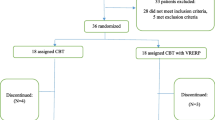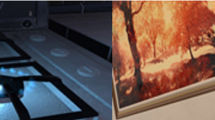Abstract
Research in obsessive-compulsive disorder (OCD) produced inconsistent results in demonstrating an association between patients’ symptom severity and their cognitive impairments. The process involved in volition aspects of behavioral syndromes can be extensively analyzed using specific tests developed in virtual environments, more suitable to manipulate rules and possible breaks of the normal task execution with different, confusing or stopping instructions. The study involved thirty participants (15 OCD patients and 15 controls) during task execution and the relative interferences. At this purpose, the virtual version of Multiple Errands Test was used. Virtual reality setting, with a higher ecological validity respect to a classic neuropsychological battery, allowed us to take into account deficits of volition and the relative dysexecutive functions associated with OCD patients. The proposed paradigm also allows the development of innovative prototypes of coevolving technologies based on new theories and models and deeper understanding of human behavior.
Similar content being viewed by others
References
Abramovitch A, Dar R, Schweiger A, Hermesh H (2011) Neuropsychological impairments and their association with obsessive-compulsive symptom severity in obsessive-compulsive disorder. Arch Clin Neuropsych 26(4):364–376. doi:10.1093/arclin/acr022
Albani G, Cipresso P, Gaggioli A, Serino S, Vigna C, Priano L, Mauro A, Franzini A, Riva G (2012) Virtual help for real surgery: the case of awake surgery. Stud Health Technol Inform 173:13–15
Blanke O (2012) Multisensory brain mechanisms of bodily self-consciousness. Nat Rev Neurosci 13(8):556–571. doi:10.1038/nrn3292
Burdea G, Richard P, Coiffet P (1996) Multimodal virtual reality: input-output devices, system integration, and human factors. Int J Hum Comput Interact 8(1):5–24
Burgess PW, Alderman N, Forbes C, Costello A, Coates LMA, Dawson DR, Anderson ND, Gilbert SJ, Dumontheil I, Channon S (2006) The case for the development and use of “ecologically valid” measures of executive function in experimental and clinical neuropsychology. J Int Neuropsychol Soc 12:194–209
Carelli L, Morganti F, Poletti B, Corra B, Weiss PL, Kizony R, Silani V, Riva G (2009) A NeuroVR based tool for cognitive assessment and rehabilitation of post-stroke patients: two case studies. Stud Health Technol 144:243–247. doi:10.3233/978-1-60750-017-9-243
Chamberlain SR, Blackwell AD, Fineberg NA, Robbins TW, Sahakian J (2005) The neuropsychology of obsessive compulsive disorder: the importance of failures in cognitive and behavioural inhibition as candidate endophenotypic markers. Neurosci Biobehav R 29(3):399–419. doi:10.1016/j.neubiorev.2004.11.006
Chamberlain SR, Menzies L, Hampshire A, Suckling J, Fineberg NA, del Campo N, Aitken M, Craig K, Owen AM, Bullmore ET, Robbins TW, Sahakian BJ (2008) Orbitofrontal dysfunction in patients with obsessive-compulsive disorder and their unaffected relatives. Science 321(5887):421–422. doi:10.1126/science.1154433
Chan RCK, Shum D, Toulopoulou T, Chen EYH (2008) Assessment of executive functions: Review of instruments and identification of critical issues. Arch Clin Neuropsychol 23:201–216
Cipresso P, Raspelli S, Pallavicini F, Grassi A, Balgera A, Gaggioli A, Villamira M, Albani G, Mauro A, Riva G (2011) Investigations of executive functions using Virtual Multiple Errands Test and Psychophysiological measures. J CyberTher Rehabil 4(2):259–260
Cipresso P, Gaggioli A, Serino S, Cipresso S, Riva G (2012) How to Create Memorizable and Strong Passwords. J Med Internet Res 14(1). doi:DOI 10.2196/jmir.1906
Cohen MA, Cavanagh P, Chun MM, Nakayama K (2012) The attentional requirements of consciousness. Trends Cogn Sci 16(8):411–417. doi:10.1016/j.tics.2012.06.013
Craig AD (2009) How do you feel - now? The anterior insula and human awareness. Nat Rev Neurosci 10(1):59–70. doi:10.1038/Nrn2555
De Geus F, Denys DAJP, Sitskoorn MM, Westenberg HGM (2007) Attention and cognition in patients with obsessive-compulsive disorder. Psychiat Clin Neuros 61(1):45–53. doi:10.1111/j.1440-1819.2007.01609.x
DSM-IV. APATFo (2000) Diagnostic and statistical manual of mental disorders : DSM-IV-TR, 4th edn. American Psychiatric Association, Washington
El Emam K, Moreau K, Jonker E (2011) How strong are passwords used to protect personal health information in clinical trials? J Med Internet Res 13(1):13–22. doi:10.2196/jmir.1335
Fineberg NA, Chamberlain S, Blackwell A, Sahakian BJ, Robbins TW (2005) Exploring neurocognitive endophenotypes of obsessive compulsive spectrum disorders using tests of cognitive and motor inhibition. Eur Neuropsychopharm 15:S529–S529
Fineberg N, Chamberlain SR, Menzies LA, Craig K, Morein-Zamir S, Sahakian BJ, Robbins TW, Bullmore ET (2008) Neuropsychological endophenotypes in families with OCD. Eur Neuropsychopharm 18:S166–S167
Goldstein G (1996) Functional considerations in neuropsychology. In: Sbordone RJ, Long CJ (eds) Ecological validity of neuropsychological testing. GR Press/St. Lucie Press, Delray Beach, Florida, pp 75–89
Heeter C (1992) Being there: the subjective experience of presence. Presence: teleoperators and virtual environments 1(2):262–271
Jeannerod M (2007) Being oneself. J Physiol-Paris 101(4–6):161–168. doi:10.1016/j.jphysparis.2007.11.005
Mantovani G, Riva G (1999) “Real” presence: how different ontologies generate different criteria for presence, telepresence, and virtual presence. Presence Teleoper Virtual Environ 8(5):538–548
Mantovani G, Riva G (2001) Building a bridge between different scientific communities: on Sheridan’s eclectic ontology of presence. Presence: Teleoper Virtual Environ 8:538–548
Menzies L, Williams GB, Chamberlain SR, Ooi C, Fineberg N, Suckling J, Sahakian BJ, Robbins TW, Bullmore ET (2008) White matter abnormalities in patients with obsessive-compulsive disorder and their first-degree relatives. Am J Psychiat 165(10):1308–1315. doi:10.1176/appi.ajp.2008.07101677
Morein-Zamir S, Craig KJ, Ersche KD, Abbott S, Muller U, Fineberg NA, Bullmore ET, Sahakian BJ, Robbins TW (2010a) Impaired visuospatial associative memory and attention in obsessive compulsive disorder but no evidence for differential dopaminergic modulation. Psychopharmacology 212(3):357–367. doi:10.1007/s00213-010-1963-z
Morein-Zamir S, Fineberg NA, Robbins TW, Sahakian BJ (2010b) Inhibition of thoughts and actions in obsessive-compulsive disorder: extending the endophenotype? Psychol Med 40(2):263–272. doi:10.1017/S003329170999033x
Muller J, Roberts JE (2005) Memory and attention in obsessive-compulsive disorder: a review. J Anxiety Disord 19(1):1–28. doi:10.1016/j.janxdis.2003.12.001
Pallavicini F, Cipresso P, Raspelli S, Grassi A, Serino S, Vigna C, Triberti S, Villamira M, Gaggioli A, Riva G (2013) Is virtual reality always an effective stressors for exposure treatments? Some insights from a controlled trial. BMC Psychiatry 13:52. doi:10.1186/1471-244X-13-52
Rand D, Rukan SB, Weiss PL, Katz N (2009) Validation of the virtual MET as an assessment tool for executive functions. Neuropsychol Rehabil 19(4):583–602
Raspelli S, Carelli L, Morganti F, Riva G, Weiss PL, Kizony R, Katz N (2009) Implementation of the Multiple Errand Test in a NeuroVR-supermarket. Virtual rehabilitation international conference, p 210
Raspelli S, Carelli L, Morganti F, Poletti B, Corra B, Silani V, Riva G (2010) Implementation of the multiple errands test in a NeuroVR-supermarket: a possible approach. Stud Health Technol Informa 154:115–119
Raspelli S, Pallavicini F, Carelli L, Morganti F, Pedroli E, Cipresso P, Poletti B, Corra B, Sangalli D, Silani V, Riva G (2012) Validating the neuro VR-based virtual version of the multiple errands test: preliminary results. Presence-Teleop Virt 21(1):31–42
Repetto C, Gaggioli A, Pallavicini F, Cipresso P, Raspelli S, Riva G (2013) Virtual reality and mobile phones in the treatment of generalized anxiety disorders: a phase-2 clinical trial. Pers Ubiquit Comput 17(2):253–260. doi:10.1007/s00779-011-0467-0
Riva G (2009) Virtual reality: an experiential tool for clinical psychology. Brit J Guid Couns 37(3):337–345. doi:10.1080/03069880902957056
Riva G, Gaggioli A, Grassi A, Raspelli S, Cipresso P, Pallavicini F, Vigna C, Gagliati A, Gasco S, Donvito G (2011) NeuroVR 2–a free virtual reality platform for the assessment and treatment in behavioral health care. Stud Health Technol Inform 163:493–495
Sbordone RJ (1996) Ecological validity: Some critical issues for neuropsychologist. In: Sbordone RJ, Long CJ (eds) Ecological validity of neuropsychological testing. GR Press/St. Lucie Press, Delray Beach, Florida, pp 15–41
Schultheis MT, Himelstein J, Rizzo AA (2002) Virtual reality and neuropsychology: upgrading the current tools. J Head Trauma Rehabil 17(5):378–394
Shallice T, Burgess PW (1991) Deficits in strategy application following frontal lobe damage in man. Brain 114(Pt 2):727–741
Slater M, Steed A, Chrysanthou Y (2002) Computer graphics and virtual environments: from realism to real-time. Pearson Harlow, Essex
Slater M, Lotto B, Arnold MM, Sanchez-Vives MV (2009a) How we experience immersive virtual environments: the concept of presence and its measurement. Anuario de Psicología 40(2):193–210
Slater M, Perez-Marcos D, Ehrsson HH, Sanchez-Vives MV (2009b) Inducing illusory ownership of a virtual body. Front Neurosci 3(2):214–220. doi:10.3389/neuro.01.029.2009
Slater M, Spanlang B, Sanchez-Vives MV, Blanke O (2010) First person experience of body transfer in virtual reality. PLoS One 5(5):e10564. doi:10.1371/journal.pone.0010564
Villani D, Repetto C, Cipresso P, Riva G (2012) May I experience more presence in doing the same thing in virtual reality than in reality? An answer from a simulated job interview. Interact Comput 24(4):265–272. doi:10.1016/j.intcom.2012.04.008
Author information
Authors and Affiliations
Corresponding author
Rights and permissions
About this article
Cite this article
Cipresso, P., Paglia, F.L., Cascia, C.L. et al. Break in volition: a virtual reality study in patients with obsessive-compulsive disorder. Exp Brain Res 229, 443–449 (2013). https://doi.org/10.1007/s00221-013-3471-y
Received:
Accepted:
Published:
Issue Date:
DOI: https://doi.org/10.1007/s00221-013-3471-y




